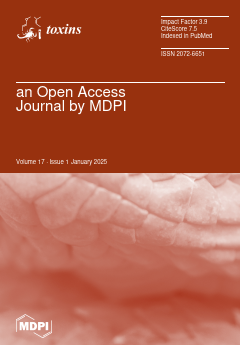Fusarium head blight, caused by
Fusarium graminearum, continues to be one of the most important and devastating fungal diseases on cereal grains including wheat, barley, and oat crops.
F. graminearum produces toxic secondary metabolites that include trichothecene type A and type B mycotoxins. There are many variants of these toxins that are produced, and in the early 2010s, a novel type A trichothecene mycotoxin known as 3ANX (7-α hydroxy,15-deacetylcalonectrin) and its deacetylated product NX (7-α hydroxy, 3,15-dideacetylcalonectrin) were identified in Minnesota, USA. In the current study, a total of 31,500 wheat spikes over a period of 6 years (2015–2020) within Manitoba, Canada, were screened for the
F. graminearum pathogen, which accounted for 72.8% (2015), 98.3% (2016), 71.9% (2017), 74.4% (2018), 92.6% (2019), and 66.1% (2020) of isolations. A total of 303
F. graminearum isolates, confirmed through sequencing of the ribosomal intergenic spacer, were further investigated for variation in the gene
Tri1, which was previously associated with the production of the NX toxin, as well as the accumulation of mycotoxins. A subset of these isolates, consisting of 73 isolates, which tested positive or negative for the NX-
Tri1-F/R assay in this study, were cultured in vitro using rice media. Mycotoxins were quantified in these samples using mass spectrometry. Using the same rice culture, genomic DNA was isolated, and the
Tri1 coding sequence along with its flanking regions (upstream and downstream of the
Tri1 gene) was amplified and sequenced. Deoxynivalenol (DON) accumulated in 96% of the cultures from these isolates, while 3-acetyl deoxynivalenol (3ADON) and 3ANX mycotoxins accumulated in 66% and 63%, respectively. Nivalenol, 15-acetyl deoxynivalenol, and NX mycotoxins were detected in 62%, 36%, and 19% of samples, respectively. A significant correlation was observed between 3ADON and 3ANX (r
2 = 0.87), as well as between DON and 3ANX (r
2 = 0.89). This study highlights the first large identification of 3ANX- and NX-producing isolates of
F. graminearum in Western Canada. In addition, it is the first identification of 15ADON chemotypes producing 3ANX in Western Canada and the first identification of 3ANX and NX-producing isolates in Manitoba, collected from wheat samples.
Full article






